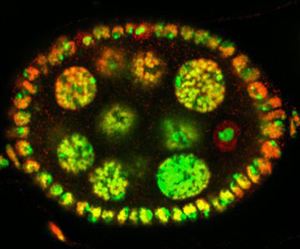Study: Fruit Flies Offer Fertility Clues
.jpg) |
|
Prash Rangan, assistant professor of biological sciences. (Photo by Paul Miller)
|
ALBANY, N.Y. (September 14, 2016) – Prash Rangan may have an answer for millions of couples experiencing infertility and it comes from an unexpected source – fruit flies.
In a new Nature Communications study, Rangan, an assistant professor of biological sciences and a member of The RNA Institute, along with his graduate assistant Alicia McCarthy, and researchers in Portugal at Instituto Gulbenkian de Ciencia and the University of Algarve, have discovered that fruit flies contain a molecular “alarm clock” – similar to humans – which could explain female fertility problems.
At the start of reproductive life, a woman’s ovary contains thousands of immature small eggs – also known as ovules – which can sit in a hibernation-like state for several decades. Until now, it was relatively unknown what triggers the genes of these eggs to “wake up” so they can grow and prepare for ovulation.
By conducting a series of genetic experiments, Rangan and the research team determined fruit fly ovules also have a resting period. Their results further revealed the timing for these eggs to awake is directly programed into their chromosomes during formation through a protein called dKDM5.
The researchers believe dKDM5 also activates the alarm clock of human ovules. Defects in the protein may cause a woman to become infertile as her ovules would fail to wake up from hibernation at the correct time.
 |
|
Ovarian follicle of fruit fly, with chromosomes stained in green and dKDM5 protein stained in red. (Photo credit: Paulo Navarro-Costa, IGC) |
“There’s not a clear understanding of the genetic basis behind infertility,” Rangan said. “Our collaborative work on fruit flies is helping to explain exactly what makes an ovule activate its genes at a specific time. We see this as a potential first step to deriving therapies which can help correct human female fertility issues.”
Rangan said the next step is to further study the dKDM5 protein and its role in egg development. The researchers are also determining why the molecular alarm clock is set during an ovules formation – long before it needs to be awakened.
For Alicia McCarthy, that means more research. She joined the Rangan Lab as a first-year graduate student in 2014 after earning her undergraduate biology degree from UAlbany.
“Prash [Rangan] has been a really great mentor for me,” said McCarthy, a native of Colonie, N.Y. “He’s passionate about his research and open to collaboration with students. I’ve been able to take a lead on developing this project. It has been an incredible opportunity.”
McCarthy is continuing to work closely with Rangan and project co-authors Rui Martinho and Paulo Navarro-Costa. The team’s research is funded by Fundação para a Ciência e a Tecnologia (Portugal) and the National Institutes of Health (NIH). Their findings were recently featured in Science Daily and Phys.org.
Learn more about Rangan by visiting his official UAlbany faculty page.
![]() For more news, subscribe to UAlbany's RSS headline feeds
For more news, subscribe to UAlbany's RSS headline feeds
A comprehensive public research university, the University at Albany-SUNY offers more than 120 undergraduate majors and minors and 125 master's, doctoral and graduate certificate programs. UAlbany is a leader among all New York State colleges and universities in such diverse fields as atmospheric and environmental sciences, business, education, public health,health sciences, criminal justice, emergency preparedness, engineering and applied sciences, informatics, public administration, social welfare and sociology, taught by an extensive roster of faculty experts. It also offers expanded academic and research opportunities for students through an affiliation with Albany Law School. With a curriculum enhanced by 600 study-abroad opportunities, UAlbany launches great careers.


